Walter Tydecks
Theses, References and Questions Regarding the History of the Memel Land
Translated from German by Marion Robinson, with some added context and references for English-speaking readers, Vancouver, BC, 2007
First some definitions
1. Memel land is also known as Memelgebiet, Memel region and geographically encompasses the south-western part of the newly independent Lithuania along the Neman River and up to Kleipeda. This low-lying land has some highest points at about 200 meters. The river flows through 3 countries but for the purpose of this article, references are to the lower western third. The land is well known for wildlife such as birds, fish and moose. Moose was the national symbol for East Prussia like the beaver is for Canada. Songs and poems sing of the deep pine forests near the sea. [1] This is a culturally significant place on earth. The Curonian spit with its pine forests and sand dunes are a UNESCO World Heritage site.
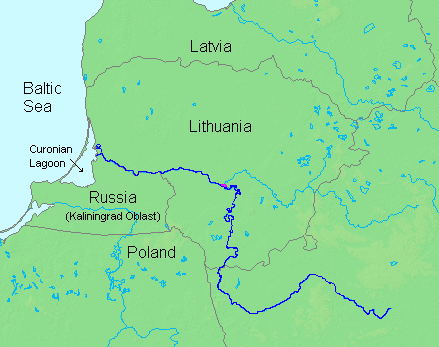
Neman River with political boundaries in 2007; Source
2. The Memel River is also known as the Neman River. It is a major eastern European River rising in Belarus and flowing through Lithuania before draining into the Curonian Lagoon and then onto the Baltic Sea at the City of Memel now called Kleipeda. The 14th largest river in Europe is navigable for most of its length of 934 km. The Memel River is a slow river. Yet, during floods, water discharge can increase up to 11 times to more volume. Severe floods occur on the lower reaches of the river about every 12 to 15 years. The Memel is an old river, dating back to the last glacial period. Today 5.4 million people live in the Memel (Neman) Basin and it is a significant economy. Once a salmon bearing system, human impacts and pollution are a concern today.
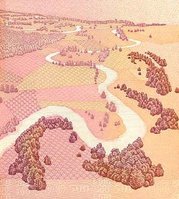
500 litas banknote featuring Nemunas loops; Source
3. Prussians in this document are Old Prussians, a Baltic tribe of people while Prussia is a German state that took its name from these indigenous people.
4. Kaliningrad Oblast is the Russian name since 1945 for the former north half of a German province called East Prussia. The old Hanseatic [3] Baltic city of Königsberg, once the seat of power, was renamed Kaliningrad after 1945.
5. Teutonic Knights (Deutscher Ritter Orden) were a crusading military order that invaded in 1226 to create a monastic state.
6. Lithuania Minor or Little Lithuania encompasses the north half of East Prussia (now Kaliningrad Oblast) and the south-western lowland of Lithuania. It is a historical ethnographic region of some branches of the Lithuanian people. With the exception of the Klaipeda Region, its territory has not been part of a Lithuanian state. Lithuania Minor enclosed much of the former German province of East Prussia, on account of the territory's substantial Prussian-Lithuanian speaking population. A small portion of Lithuania Minor is within the borders of modern Lithuania while most of the territory is now part of the Kaliningrad Oblast of Russia.
Although hardly anything remains of the original culture due to the expulsion of the East Prussian population after World War II, Lithuania Minor has made an important contribution to Lithuanian culture as a whole. The written standard form of Prussian-Lithuanian provided the "skeleton" of modern Lithuanian. It was the home of Kristijonas Donelaitis, pastor and poet and author of The Seasons, which mark the beginning of Lithuanian literature, and Vydunas, a prominent writer and philosopher.
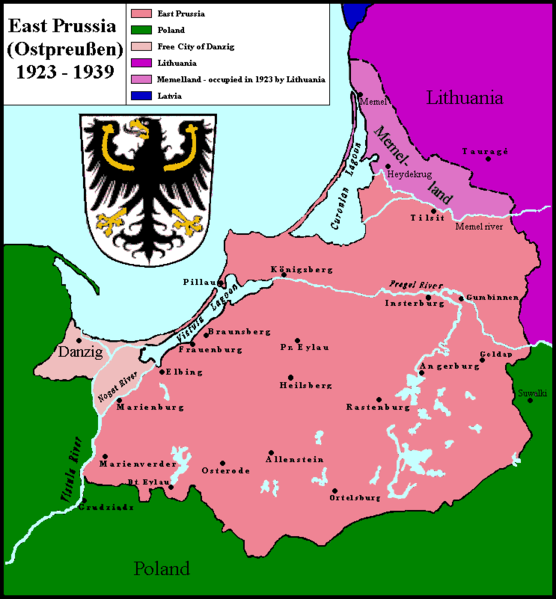
East Prussia from 1923 to 1939 between the Wars; Source
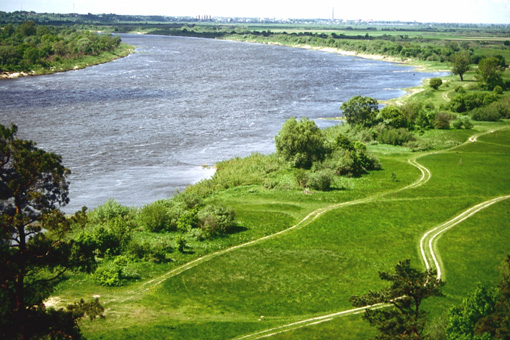
View from Rombinus towards Tilsit. Photo: Andreas Degen; Source
About the Memel Lands - My Interest In The Topic
One cannot pose questions regarding the history of the Memel Land without raising political, religious and world-view controversies. So many variables came together in this one geographic region:
- The Baltic group of languages, German and Slavic languages,
- The indigenous people's last resistance to Christianity in Europe,
- Language borders along ancient trade routes and waterways that became bisected by
- Protestant and Catholic divisions; and finally
- Prussia, Lithuania and Poland appointed themselves to this region while they were gaining their might and national identity in the 19th century. Prussia took on the dominant role in Germany.
- Other languages like the more ancient Curonian (Kuri) and Prussian (Prussi) succumbed to the dominant cultural overlay. Officially extinct since 1701, they were unable to form the critical mass required to form Curonian and Old Prussian branches of a larger nation. It is still disputed who took over the indigenous "historical rights"; whether it was Lithuania, Germany or Russia, which occupied the northern half of the former East Prussia.
Since 1945 many questions remain. Even after more than half a century, stresses remain in this ancient ethnographic region. In 1945, after the populations were forced out, what is today called ethnic cleansing, the Memel Land on the north side of the river was resettled by Lithuanian populations while the south side of the river (former East Prussia, now Kaliningrad Oblast) is "Russificied". This cuts across ethnic and natural geographic boundaries. Could there be any other reasonable solution for future peace than to reach a new inclusive identity under the new European Union in this singular ethnic and geographical area? At the same time, the new independent state of Lithuania (since May 2004) struggles with Russian dominance and the abuse of the agreed-upon transfer of rights.
Not every ethnic or political group understands current affairs in the context of the continued history of the region. One might expect that the history would be of interest to those currently living there, both Russians and Lithuanians. They could benefit from a positive relationship not only to the history but the former inhabitants, their descendants and the memories of their former homeland.
Yet it is not so easy as this same history has left unresolved pain and trauma everywhere. After 1945, the forced expulsions and death of 15 million ethnic Germanic people from Eastern Europe and the resettlement of other peoples in their place left generational problems. From the Memel and East Prussian region nearly 2.8 million people had to leave in the cold winter of 1944-45 as the Russian front advanced. Many did not survive. Those that did focused on getting on in their new settlement in the west. This was complicated by lack of resources and difficult reception of displaced persons in West Germany. The Memel Land and East Prussia suffered under Russian occupation. At the same time Russian authorities brought various ethnics from points east to now settle in this region that in turn was not their homeland either. They also felt unsupported and had to deal with their own hardships. Even though Lithuania now has independence, many still have not recovered from the Soviet era.
To be fair, not all blame can be left with the Soviet domination, as Lithuanian people that moved into the Memel region after 1945 also need to ask themselves:
- How did they embrace the Soviets?
- What about their own participation in anti-Semitism? and
- Their destruction of most of the gravesites in the region?
Another point: The question as to the needs of German refugees is still in denial by the Allies and the West German government. It's like western revenge [4] to not be interested in questions [5] such as why were the remaining ethnic groups like the Nehrungskuren, not settled together in the west? They could have retained their work, language and cultural values. Instead this is now lost. It has to be assumed that western powers wanted to avoid addressing the needs of the refugees.
In their new settlement areas, the refugees formed homeland associations. Most were formed around a sister-city in West Germany. What roles did these homeland associations play? They held large reunions and maintained an archive from what information was saved. The homeland associations served their participants with a joy in seeing each other and the luck of their own survival. There was no doubt about their strong anti-communist sentiment and they were therefore drawn into the cold war. This did not enable relationships with the east.
Lithuania has undertaken a more open approach to reviewing recent history while this topic remains taboo with the interests of the Allies and postwar German politicians. Even the German reunification of 1989 did not change this. Internal censorship ended in the former East Germany where now literature like Guenther Grass' "Crabwalk" is being embraced. His writing raises these issues but gets no mileage in the west. In particular the question about the relationship to the USA remains unanswered. The strong emotional reactions are either critical of anti-American sentiments or critical of a blind following.
Even today, hardly anyone asks what the ethnic cleansing of our own families means for us and the coming generations [6]. History is not seen as a continuum of cause and effect. Instead the 1960s are held up as the new wonder of the post war period (that in itself has its own mythos) and are blamed as the source of all our problems such as family breakdowns, social ills and the poor state of the German economy.
As the public and decision-makers do not come from a trauma-informed approach and prefer to ignore these questions, every attempt to bring this up is met with aggressive and defensive responses. (Psychologists explain that this in itself is a trauma response. Its like getting an over-reaction when a "nerve is touched".) It is important to move society beyond avoidance and denial as these unresolved inner conflicts can pose a danger when they are turned outward. The psychological split caused by denial of history and identity could be expressed outward as scape-goating others. It may look like there is a demand not to know and not to remember the past. An act of simple validation may shift this. At the same time, if we continue on the same path, we may experience the domination of an economic might in the new European Union and the cycle repeats itself.
The denial and non-validation simply carries unresolved issues into the future [7]. Subsequent generations may not know how to connect to the source of the problems. This lack of knowledge would prevent the insight that can be gained from the validation of a people and their history. Therefore we raise the questions such as: just like an individual, should not a nation heal beyond the denial, anger and post war stress disorders [8]?
These questions are not meant to replace historical works and sources of study but rather to provide deeper insight and awareness. The controversial issues are not for more finger-pointing but rather to heal generational harm so we can move into a healthy future.
The following page is draft and will require further refinement ...
Regarding the History of the Memel Region
Who were "the first" to live in the Memel region? Is that even a relevant question? Archaeological evidence proves that there was settlement since 3000 BCE. The Goths lived here in the 2nd and 3rd century with subsequent overlays of Curonians and Old Prussians. What distinguishes a people from nations? And from who's point of view? What is nationhood? It that a projection of a 19th century political concept that gained momentum out of the enlightenment period when the church was losing its hold and its influence on identity?
Language boundaries often distinguish geographical regions with the common understanding that a common language defines a nation. The various dialects further define a people within a nation. In turn, related languages can bridge together to form a larger language like English is today. Also language provides cultural identity and a sense of self as in "the mother tongue". Language is the link to our old people, our ancestors. Even when story details fade with time, the voices remain within the language. The suppression of languages has always been a successful tactic in the destruction of a people [9].
Further versions of Memel Land history have been brought to us from Roman interpretations:
- Romans called the people Aesti which we know are not Estonians but rather the Baltic people or Balts
- Samogitia, and extending into what we today call White Russia or Belarus (and only since von Bobrowski's [10] cultural expression about a much larger region in the east where the Balts were introduced).
Language
Overlooked and provided here for clarity:
- The Balts belong to the Baltic language group while the Estonians belong to the Finnish-Ugric group of languages. The Roman reference was to the Aesti which were the Balts.
- The Baltic group of languages included the Old Prussians, Curonians, Lithuanians and Latvians; each with their own language. Curonian and Latvian were very closely related. These cultures were the forerunners for modern nations. Both Estonia and Lithuania went on the achieve nationhood.
- Schalauer (Shalovians), Nadrauer (Nadrovians) and Sudauer (Sudovians) were branches of the Old Prussians in the region west of the Memel.
- Zemaiten and Akstaiten were branches of Lithuanians that settled somewhat east and southeast of the Old Prussians.
- To confuse this even more, all the various peoples that spoke the different languages of the Baltic language group have been rolled into one and simply been referred to as a single Baltic people. [That is like saying that a Dutch person is German as both of them speak Deutsch/Dutch. Even in the USA the Pennsylvania Dutch are Deutsch.]
Since the Old Prussians and Curonians have lost their critical mass and their land, all that is left are the remaining elements, such as:
- Curonian held on for a relatively long time as an identifiable separate language but was only really spoken in the few fisher and farm households along the coast and on the Curonian Spit. Politically this became the borderland between East Prussia, Lithuania and Latvia.
- Elements of the Curonian and Old Prussian dialects were integrated into the mainstream Lithuanian language in the rural areas around Memel and formed the new dialect of lowland Lithuanian on both sides of the Memel River. This language area was also known as Lithuania Minor (also Little Lithuania, Prussian-Lithuanian or Buriskai). All Lithuanians could understand this dialect and even the Latvians can make it out. These dialects had minor differences from village to village. Compared to this Lithuanian dialect, the German and Slavic (Polish) languages were truly a foreign language.
- Within the city of Memel (Klaipeda), German was always spoken, partly due to the history with the Hanseatic league and other influences. It was a port city. West of Memel the German language suppressed the Old Prussian and only certain words, place and family names remained. Some words remain and today are recognized as East Prussianisms. For example: "De Lorbass hat de Marjell janz armbatschig jegrappscht." While in German it would be "Der Luemmel hat das Maedchen sehr grob angefasst." (The jerk grabbed the girl rather hard.)
- So what has remained is a recognizable East Prussian way of speaking whose grammar and expression out to the Lithuanian can sound irritating to high German speakers. This difference defined city people from country folk in the region.
- The rigorous Germanization reached a highpoint under Bismarck in the 1870s [11]. Consequently even the names were made more German. For example: by replacing the Lithuanian "y" with the German "ie" as in Zydat to Scheidat; and by dropping the feminine version of last names like Tiedecks instead of Tydecka.
- By 1938-39 even the place names were completely Germanized. Like places that for thousands of years were called Pillkallen became Schlossberg, Berschkallen became Birken; a few like Karkelbeck and Plicken were spared.
Teutonic Knights (Deutscher Ritter Orden) and the Crusades
Most people are familiar with the Crusades to the Holy Land during the Middle Ages but may not know about the Crusades in the Baltics. In recent times, a crusade, in the religious and warlike sense, has generally been regarded simply as an ugly phenomenon from the Western world's blood-stained past, without much consideration being given to the actual origins of the term. To the Christian peoples of the Middle Ages the Crusades had a very specific meaning. It was a series of expeditions intended to remove a perceived threat to the Christian faith or to convert non-Christians to Christianity, by force if necessary. These Crusades were sanctioned by the Pope who was Christ's representative on earth. Participating in a crusade offered many benefits. While a man was on crusade, all his assets were protected; they could not be seized in payment of taxes or other debts. All his sins were forgiven, including those committed while on crusade. A crusader could not be prosecuted for any crimes committed and any loot taken could usually be kept. Some historians write about the fact that the crusades were a means for rulers and communities in times of peace to rid themselves, at least temporarily, of landless and burdensome younger sons of the propertied classes and of greedy and troublemaking noblemen. Crusaders took part because they believed in what they were doing on behalf of the Church and for God.
This assertive mentality and violent action foisted itself on the indigenous people in the Baltics. The Teutonic Knights invaded the Memel land around 1235. They constructed numerous castles in the region from which to wage their campaign. They built castles in Marienburg, Balga, Koenigsberg, Ragnit, and Memel among others. The Teutonic Knights responded to an order made by Masowiens (then an independent Polish Principality) and supported by the Pope through the Staufer kings (Swabian Royal Houses). This invasion was definitely an act of force, power and violence. To speak of the Teutonic Knights as founding a nation or to speak of them as taming an unoccupied wilderness is obviously the victor's point of view. The Knights motto was "where ever I place my foot, that will belong to me and what defines culture and history, I will determine".
The Knights annihilated the indigenous people. Their domination was characterized by blood-letting and ruthless cruelty. Most local tribes stood up to them but could not hold out against their resources and medieval war methods. An example of a tough tribe and among the last to be "Christianized" were the Samogitians; [12] adjacent to deep forests and swamps, they had a bit of strategic advantage. But after a hundred years of this onslaught the land was emptied by force. Then when history writers say there was an unoccupied wilderness 100 years after the Knights invaded, it means that the Knight's destruction was complete in the old areas of Schalauen, Sudauen and Nadrauen.
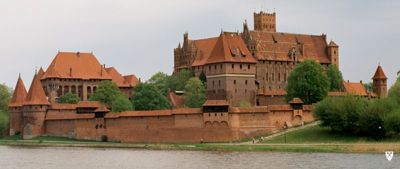
The fortress Ordensburg Marienburg, founded in 1274, the world's largest brick castle and the Teutonic Order's headquarters on the river Nogat
[At the same time, a 750-year-old collective blame cannot be laid on all Germans for the Teutonic Knights as the majority of Germans and German-speaking people arrived in Lithuania Minor after 1700. In 1870 the German authorities held up the Teutonic Knights as national and spiritual heroes with which East Prussia was to identify. This was a bad move as it tore open old wounds in the region.]
After the historic and final battle at Tannenberg in 1410, the Teutonic Knights were done. Only after this time did neighbouring Lithuanian settlers move back into the then wild and abandoned region along the Memel River. These ethnic people were unable to free themselves from a degraded status in the eyes of the authorities. Only a few Old Prussian high status people were allowed to be land/estate owners and later were absorbed by the German-Prussian hierarchy.
Since 1355 the Teutonic Knights had dominated the Old Prussian people as was ordered by Masowiens so this now feudal state was obligated to Poland and belonged to the Holy Roman Empire as was Germany. This authority remained until the end of the 30-years war around 1660.
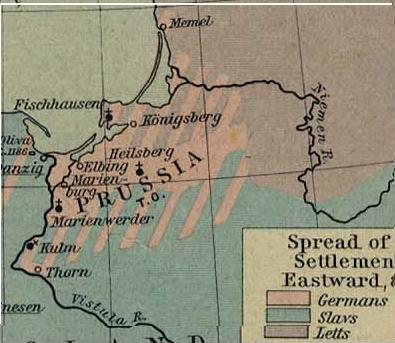
Ethnic settlement in East Prussia by the 14th century; Source
Jewish Settlement
Prior to 1700, Jewish people were fleeing their persecutions in Spain and Portugal. They came to the Netherlands, then Germany and after many pogroms like in Cologne and Worms, they continued eastward. The Lithuanian city of Vilnius was known as the Jerusalem of the east. Only during the best times of the enlightenment [13] with the Proclamation of People's Rights and Peace was there hope that Jews would be treated as equals.
In the Memel region there were relatively few Jews. In 1875, 700 out of the 1000 Jews in Memel had left after Bismarck expelled those not taking German citizen ship. In 1925 there were 5,000 Jews in the City of Memel and in 1938, 9,000. Jewish communities existed in Heydekrug and Rusne. There were no Jews in the rural areas.
Nation Building and the Catastrophe of 1710
In 1525 the Teutonic Knights converted to Protestantism while Poland and Lithuania remained Catholic. Sweden became the dominant power in this region after the 30-years war. They partnered with the then trade-dominant Netherlands. From 1660 to the time of the French revolution, Sweden was looked to as the model of enlightenment [14] and modernization. In comparison, after 1649, Prussia and Russia fell back into a feudal system that included indentured servitude.
As in England, the decades-long political strife ended with their revolution in 1680, so ended the Dutch dominance in world trade. This also caused Sweden to lose its hold in the Baltic east and was pushed back by the Old Prussians in the Nordic War. Besides Sweden, Poland lost status as well. After the division of Poland in 1772, the Old Prussian and Russian interests collided at the Memel River.
The Nordic war was a catastrophe of historic proportions in the East Prussian region. In addition to the acts of war, it brought the plague via the movement of people. Almost half of the indigenous Old Prussian population died. Populations were so decimated that the traditions and culture of the Old Prussians were so weakened that they could never achieve any form of statehood, unlike the Latvians and Estonians.
Even though this region had had a majority of the Lithuanian ethnics that remained as the descends of the Old Prussians, including the Curonians which were situated along the Baltic Sea coast, new Lithuanian settlers came into this region. Yet far more intensely, the German state of Prussia organized the immigration of colonials. These included persecuted Salzburg Protestants, French and Swiss Huguenots, Scotts and other ethnic groups. Friedrich, the Soldier King, modeled the building of the modern German Prussian state after Sweden and France. This effort required skilled trades people and farmers. Friedrich magnanimously took in over twenty thousand people, hoping to repopulate the eastern regions of the Prussian realm devastated by plague and famine. He also promised religious freedom and provided start-up funds and assets. Prussia was hailed as most reputable by those leading the enlightenment (Voltaire, Leibniz) while Prussia had a brutal internal policy towards its indigenous people where indentured servitude continued until 1813 and many random acts of brutality were perpetrated to those that served under landowners or the army.
In relation to bringing in the skilled workers in the 18th century, dike builders from the Netherlands were brought to East Prussia. For example, it is likely that the ancestor of the Tydecks arrived this way. A rather high sand dune north of Memel is still called the Dutch Cap. In the Etymology of Lithuanian Family Names, Aleksander Vanagas suggests that Tydecks is originally from German in the form of Dietrich. This was the same name chosen by the two Tydecks that emigrated to New York in 1900 so as to be differentiated from eastern Europeans (that were not as well received into American society at that time).
The newly settled colonials in the German state of Prussia were exempt from indentured servitude. This was also part of the conflict between Prussian kings and local aristocracy. The power of the local aristocracy depended on the time worn tradition of local fealty from the indentured farmers, while the Prussian king expected to achieve power with the help from the colonial settlers.
There was also an unstable power struggle between Prussia and Russia. While both sides were engaged in this competition, it made room for a third power like France to show interest. This was not a recipe for peace. (One could also suggest that in today's world that similar roles are being taken where American interests are like those of historical France. Lithuania sees itself in a tough spot between meeting German pressures while trying to keep Germany as a partner at the same time as seeking renewed relations to Russia and Poland.)
After Napoleon had swept thru this region and even had a meeting with Queen Louise in Tilsit in 1807 where she tried to convince him not to wage war, the Grand Armee was defeated in Russia. On Dec 30th, 1812, General Yorck signed an armistice with Russian troops called the Tauroggen Convention. This was the tipping point towards the German War of Liberation the following year. Thus Prussian Reforms were instituted [15] as an act towards modernization which was seen as against French occupation. One of the reforms was the emancipation of all Prussians. Farm workers now could earn their land, or be free to choose other occupations. This brought about great social and economic change.
These conflict-laden social and economic changes made it seem like Prussia, Poland and Lithuania were fated to have problems in the development of their national identity. For example:
- The Lithuanian language emerged in East Prussian exile, (later also as Prussia was motivated against Russia).
- Also the first Lithuanian publishing and the movement regarding Vydunas [16] found fertile ground in East Prussia.
- In contrast to the Catholics, the Protestants promoted local languages.
- A paradox ensued where Catholic Lithuania got its language back that was saved in Protestant exile in East Prussia.
For example: in 1547 the first Lithuanian book, the Catechism of Martynas Mazvydas [17], in 1653 the Bible translation of J. Bretkunas and the first grammar of the Lithuanian language. The tradition was carried on in the 17th century by Wagner, Pretori, Harknoch and Lepner. In the 18th Century the first classical work of Lithuanian Literature was published; K. Donelaitis' poetry [18]: The Seasons.
- At this time of development, where was the nucleus for Poland? Were Mickiewica and later Milocz, Poles or Lithuanians? The impulse came from Vilnius. Was Vilnius therefore Polish, Lithuanian or even Jewish? The centuries of Polonization of Lithuania was strongest in Vilnius.
- In post-war English language writing, Copernicus is hailed as a Pole but he was an Old Prussian who's ethnic identity existed before the modern national identities we assign to past notable people today.
- The state name of Prussia was drawn from the tribal name of the Prussian people (which I have differentiated in this document by including the adjective "Old" before the name.) Prusa means "near water" or "people of the river". The Prussian tribe or Old Prussians were considered as being related to the Lithuanians. The Old Prussians were harshly oppressed by the Teutonic Knights. The Prussian language is closely related to Lithuanian but at the same time reflects German culture and language. The actual statehood-Prussians came from the German lands of Brandenburg and Pomerania.
A nationalistic turn in the 19th century established the German Reich (Empire) under Prussian supremacy and imposed an increasing pressure on all national minorities, also with the Lithuanians in East Prussia. However, contrary to other national minorities in Germany only the Prussian Lithuanians remained monarchists. Silvia Pocyte explains this as the influence of the Protestant Church and how piety is linked to the monarchy. The other national minorities, for instance, the Poles in West Prussia had their own identity, both over the language and their religion (Catholic in the Ermland).
Social Problems around 1900 and Agri-Economic Crisis
The abolition of indentured servitude (bondage) in Prussia after 1813 led to the incremental destruction of the old social structures of the village community. The new market economy forced farmers to compete. Only those that had the means of new production methods like artificial fertilizers and mechanization could compete but the downside was increased farm debt. The world market and shipping was changing towards new and larger economies, especially after the American Civil War in the 1860s. Commodities transportation such as new rail and transoceanic shipping lead to an over supply which pressured farmers in many parts of the world. The winners were the transportation companies and trading venturists. This is an early example of globalization and its victims.
Thus the Memel region found itself in an economically desperate situation. As it was politically at the extreme eastern edge of the German empire it was cut off from its geographical natural hinterland as in the Basin of the Memel River. Even with new farming methods it could not compete with other German provinces like Pomerania. It was the same for Poland, Sweden, Lithuania and Belaruse. Approximately one fifth of the population in these lands looked to emigration to North America as their only solution. When they arrived in the new land, most of these immigrants settled around Chicago and the Prairies where they found a similar climate and access to land.
Due to mass emigration early this century and especially because of the Soviet takeover in 1944 which forced many Lithuanians to flee, there are now over three million people of Lithuanian decent living outside the country. Some 800,000 Americans claim Lithuanian heritage [19].
Example of social conditions:
Except from article: Old People in Lithuanian Villages at the Beginning of the 20th Century by Manfred Klein in the Annaberg Annals, 2000:
Extreme poverty menaced the aging population and the families that cared for them. With the onset of deteriorating social and economic conditions, differences arose between the generations. For example: the older generation would sell the farm too early and become dependent on their children or would sell the farm too late, which made it economically difficult for the next generation. Many farms found themselves in bankruptcy. In most cases the farm went to the oldest son who then had to look after the parents while paying out his siblings.
Within the City of Memel, conditions were a little better which created tension on the urban-rural interface. Memel could take advantage of its participation in the "happy and well-off German Monarchy before 1914" [20]. During this time many civic building projects were undertaken: the Queen Louise School, the Victoria Hotel, the City Hall, the Train Station, the Royal Post Office, the Royal Teachers Academy, the Augusta Victoria School and the Barracks which today are the university.
No indigenous elite developed in Lithuania Minor. Religious and political connections were in Memel and Prussia, but the language base was in Lithuania while the family names were predominately Old Prussian, Lithuanian and Curonian. The ethnic population could find no solid identity between the larger Prussia and Lithuania. As Prussia offered better economic opportunities and Lithuania was still under Russian rule many chose to take part in the Prussian-German economy [21].
1919 to 1944 and the Security of Rights after the First World War
After the First World War, western powers intended to ensure no future opposition by "dividing and conquering" Germany [22]. This kind of division also occurred later in Yugoslavia, the Polish corridor and the Memel Land where the important harbours were systematically isolated from their hinterland. This was a policy of the "victors" or the dominant forces after a conflict. It was meant to weaken the economy of the "losing" nation.
Until this point, the Memel Land was a geographic description. It was defined politically as in having political rights in the statutes after 1919. Memel and Danzig became political footballs of the super powers.
The Memel Land had Lithuanian occupation through to 1923. It put up with German dominance to avoid Polish claim but at the same time suffered anti-Lithuanian tendencies. After 1933, the region had economic boycotts and in 1939 felt the all-encompassing wave of the Third Reich [23].
In 1939 west and central German National Socialists replaced all governing appointments. The political locals that were once "true-to-Germany" were let go. There were few exceptions. One exception was the Hitler Youth manager for Memel City and Land, that earlier had organized and politicized the patriotic German youth group, known as the Eagles and Falcons. This man was charged under Lithuanian courts in 1934-37 with acts against the state.
There were problems for those that chose the option of remaining Lithuanian after 1939. Under difficult circumstances they were brought to Germany. For those that survived, when they returned home to the Memel Land after 1945, they found their farms and assets occupied by new Lithuanian people that had been drawn to an "empty area".
Soviet Times and Gravesites
The best overview can be found in Stribrny's presentation commemorating 750 years of the city of Memel/Kleipeda [24].
The obliteration of gravesites:
Martinas Purvinas presents the destruction of 90% of the gravesites as consciously targeting that what was held most sacred. This is comparable to other crimes against humanity that have never really been looked at, validated or documented. This was a heavy blow for those that had gone back to resettle their homeland after 1945; and for those emigrants and their descendants whose thoughts have never left the homeland.
In "The Indigenous Civilian Population of the Memel Region During The Soviet Occupation", Arbusauskaite writes about the time right after 1945 but the points made by Purvinas are omitted.
Current Affairs
It is hoped that the EU framework can solve some of the issues.
Life in the new independent state of Lithuania has some very contrasting parts to it. There is great poverty in the lowland settlements where just about everybody is unemployed. These people were settled there, year after year by the thousands, during the Soviet times. This is contrasted by a new economic class that have found a way to wrangle through the new privatization of the state regime to their own benefit. While at the new university there is a spirit of openness where history and its controversies are worked on and questions are being asked.
Yet there are challenges as further political issues are brought up:
- Since independence there is a self-aware kind of nationalism that still needs to find its own balance [25] .
- American and Canadian emigrants and their descendants stimulate ideas that include connecting the Russian part of Lithuania Minor (Kaliningrad Oblast),
- Some voices from the extreme right of the political spectrum dream of a new German state.
After 1945, the strongest opposition to the Russian occupation of Lithuania Minor/East Prussia came from those exiled in the USA, Canada and Australia while the western super powers thought that Russian occupation was ideal. Those exiled even formed Lithuanian parishes; they resourced research like the promotion of the original place names and now a project called the Lithuania Minor Encyclopedia. Along with this effort are expectations around the return of Kaliningrad Oblast to Lithuania including the towns of Tilsit, Labiau, Ragnit, Insterburg, Pillkallen and Gumbinnen. Promotion of these ideas stresses Lithuania as it is very clear that the Russians are not interested. Most of the Lithuanians that live in the region today have survived Siberian exile and are making the most of the old home ground.
From the Baltic Times, July 25, 2007:
The Russian enclave of Kaliningrad has been thrust in to international spotlight recently, primarily, thanks to Russia's threat this month to deploy ICBMs (intercontinental ballistic missiles) in the region - a response to U.S. plans to install a limited anti-ballistic missile shield in Poland and the Czech Republic. For Lithuania, the prospect of an even further militarized Kaliningrad is an unsettling one and complicates an already complex relationship with its neighbour.
Appendix 1 - Flight and expulsion of Germans during and after WWII
The flight and expulsion of Germans during and after World War II refers to the forced migration of German nationals (Reichsdeutsche) and some ethnic Germans (Volksdeutsche) from various European states and territories 1943-1945 and in the first three years after World War II 1946-48.
Many Germans fled their areas of residence under precise evacuation orders of the Nazi German government 1943, 1944, and in early 1945, or based on their own decisions to leave in 1945-1948. Others remained and were later forced to leave by local authorities.
The majority of the flights and expulsions occurred in areas of today's Czech Republic, Poland and Russia. Others occurred in territories of today's Slovakia, Hungary, Serbia (predominantly in the Vojvodina region), Lithuania, Slovenia and other regions of Central and Eastern Europe.
This forced migration of ethnic Germans resulted in the transfer of between 13.5-16.5 million people and was the largest of several similar post-World War II migrations orchestrated by the victorious Western Allies and the Soviet Union. Over the course of the sixty years since the end of the war, estimates of total deaths of German civilians have ranged from 500,000 to as high as 3 million. Although the German government's official estimate of deaths due to the expulsions stood at 2.2 million for several decades, recent analyses have led some historians to conclude that the actual number of deaths attributable to the expulsions was actually much lower-in the range of 500,000 to 1.1 million. The debate about the number of deaths and their cause continues to be the subject of heated controversy.
More than half a century later, relations between unified Germany and its East European neighbors remain somewhat difficult due to an often emotional controversy concerning the rights of expellees (German: Heimatvertriebene). Much of the controversy is spurred by contentious demands of some groups of the expellees or their descendants for revocation of expulsion decrees, official apologies, prosecution of perpetrators, or compensation for lost properties. Underlying this controversy are disagreements about who was responsible for the expulsions, what the motivations were and whether the expulsions were morally justified.
Appendix 2 - Vydunas
Vilius Storostas-Vydunas, or Wilhelm Storost ( March 22, 1868 Jonaten (lit. Jonaiciai), near Heydekrug (lit. Siluté), Prussia - February 20, 1953 Detmold, Germany) was a Lithuanian writer and philosopher, a leader of Lithuanian national movement in Lithuania Minor, one of leaders of the theosophical movement in Eastern Prussia. Wilhelm Storost was his passport name, while Vilimas or Vilius Storostas was more correct Lithuanian form, that was used by himself, his family and other Lithuanians, but Vydunas was his new surname, used as a pseudonym (a pen name) too, added to the first, when he was about 40 years old.
Vydunas was active in the old pagan religion of Lithuanians (see Romuva). However he never declared revival of the pagan religion as either his personal goal or a goal of Lithuanians, remaining a national leader but not a religious one. Again his moral influence transcended confines of being a typical political leader or a writer at his time. He was compared by later biographers with national leaders in India of his time like Rabindranath Tagore or Mohandas Gandhi. Pantheistic universalism, not predefined with participating in any obligatory religious practice, was one of the leading ideas of his philosophy, and gained him later fame as a pioneer of both pagan revival and theosophy in Lithuania. He was considered as candidate for Nobel Prize.
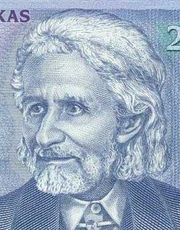
Vydunas as featured on 200 litas banknote (1997 release); Source
Recommended reading:
Endre Bojitar. Foreword To The Past, A Cultural History of the Baltic People. First Published in Hungarian as Bevezetes a baltisztikaba by Osiris, Budapest 1997. Central Europoean University Press. 1999.
[1] For example: Land der Dunklen Waelder.
[2] n/a
[3] The Hanseatic League was an alliance of trading guilds that established and maintained a trade monopoly over the Baltic Sea, to a certain extent the North Sea, and most of Northern Europe for a time in the Late Middle Ages and the early modern period, between the 13th and 17th centuries.
[4] Alfred-Maurice de Zayas. A Terrible Revenge, The Ethnic Cleansing of the East European Germans. Palgrave McMillian, New York, 2006. Originally published as Anmerkungen zur Vertreibung der Deutschen aus dem Osten. Verlag W. Kohlhammer, 1986.
[5] See Appendix 1
[6] Except the articles by Helga Hirsch (b.1948, Journalist, Corresondent): 1998: Bewältigen oder Verdrängen? Der deutsche und der polnische Umgang mit der jüngsten Geschichte. In: Ewa Kobylinska/Andreas Lawaty (Hg.): erinnern, vergessen, verdrängen. Polnische und deutsche Erfahrungen. Wiesbaden: Harrassowitz (= Veröffentlichungen des Deutschen Polen-Instituts Darmstadt, Bd. 11). S. 78-86. ISBN 3447040807 2003: Flucht und Vertreibung. Kollektive Erinnerung im Wandel. In: Aus Politik und Zeitgeschichte, B40-41/2003, S. 14-26
[7] Bloom, Sandra. Creating Sanctuary. Routledge, 1997. Brundtland, Harlem, G. Mental health of refugees, internally displaced persons and other populations affected by conflict. Actr Phychiatr Scand. 2000 Sep;102(3):159-61. Miller, Alice. For Your Own Good (Am Anfang war Erziehung), Suhrkamp, 1980.
[8] There are many parallels to the experiences of First Nations in Canada. -MR.
[9] Now coming to light with First Nations and Hawaiian language suppression.
[10] Johannes Bobrowski (born April 9, 1917 in Tilsit, died September 2, 1965 in East Berlin) was an important German lyricist, narrative writer, adaptor and essayist.
[11] Franco-Prussian war of 1870-71.
[12] Charles L. Thourot Pichel, Samogitia, The Unknown In History. 1975
[13] See below.
[14] Aufklaerung (German: Enlightenment), in Germany, the 17th- and 18th-century philosophical movement that emphasized rationalism. In Germany the Aufklärung found its highest expression in a science of government. One explanation lies in the importance of universities. There were nearly 50 by 1800 (24 founded since 1600); they were usually the product of a prince's need to have trained civil servants rather than of a patron's zeal for higher learning.
[15] By Heinrich Friedrich Karl Freiherr vom und zum Stein and Kart August Fuerst von Hardenberg.
[16] See Appendix 2.
[17] Talk given at the New York Public Library on April 2, 1997, by Elona M. Vaisnys, Yale University, Link
[18] Lithuanian Lutheran pastor in East Prussia, Donelaitis, would write an extraordinary literary work, The Seasons, evoking life among Lithuanian peasants in East Prussia. In the 19th century, when Lithuania was under Russian rule, Lithuanians were forbidden under penalty of incarceration or exile to Siberia the possession and even more so printing of Lithuanian books and newspapers in the Roman alphabet. So, Lithuanian books and newspaper would be printed in East Prussia and "book carriers" would smuggle them into Lithuania. Two thousand of these brave men and women! - were exiled to Siberia for their commitment to the Lithuanian printed word (this prohibition was in force for 40 years, until 1904). Link
[20] As written by Wolfgang Stribrny.
[21] The National Identity of the Prussian Lithuanians by Silva Pocyte.
[22] MacMillan and Hollbrooke. Paris 1919.
[23] Bobrowskis novel "Lithuanian Pianos" describes this situation after 1934.
[25] Ruth Leiserowitz.
© tydecks.info 2007


